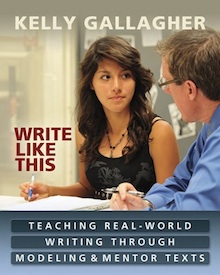Raising Real-World Writers
Write Like This: Teaching Real-World Writing Through Modeling & Mentor Texts
By Kelly Gallagher
(Stenhouse, 2011 – Learn more)

The day had been filled with optimistic speakers who explained how literacy strategies could be taught and assessed in a variety of ways. Indeed, the many topics reflecting the theme of the NYSRA 2011 conference, “Connecting Multiple Literacies,” all led back to the feasibility and importance of reaching our young readers and writers through the use of various media and texts.

Kelly Gallagher is first and foremost a high school English teacher in Anaheim, CA, and he has written a series of books (including Readicide) that address the challenges of teaching and learning in the 21st century era of “teaching to the test.”
Write Like This: Teaching Real-World Writing Through Modeling & Mentor Texts addresses the need for the development of writers who will be able to succeed in whichever career they choose. Gallagher writes that “…writing well has become a gatekeeping skill across the workforce” (3). He cites the fact that 7 out of 10 graduates do not have the writing skills needed for entry to most careers. To address this deficiency, he strives to foster two tenets in his writing classroom: to expose his students to as much real-world writing as possible and to provide multiple opportunities for authentic writing.
A look inside the book
The format of this book is constructed to address 6 purposes of writing:
- to express and reflect
- to inform and explain
- to evaluate and judge
- to inquire and explore
- to analyze and interpret
- to take a stand and/or propose a solution (Bean, Chappell, Gillam 2003)
Gallagher devotes an entire chapter to each of the purposes listed above and takes us through the implementation of several activities which help develop each kind of writing. He shares my mantra that all teachers need to show the struggles of writing to students through daily use of modeling. In my work as a literacy coach, I have been amazed at the number of teachers who are hesitant to write in front of students. Gallagher speaks to the need for the expert writer in the room to model the struggles involved:
When my students see me wrestling with decisions as my writing unfolds, it gives them insight on how to compose their own pieces. I don’t tell them how to draft their papers; I show them how I draft my papers…You are the best writer in your room; your students need to stand next to you and see how you struggle with the process as well (15).
And this is what I love about Gallagher: he practices what he preaches. In Write Like This, he takes the reader by the hand and shows how the teaching process occurs in his own classroom, warts and all. We see his rough drafts as well as several student examples, and sandwiched in between are the steps to developing each of the purposes.
The structure of Chapters 2-7 is the same:
- Gallagher shares a mentor text ( a piece of writing that serves as a model for the young writers) for each activity
- He models the type of writing
- He shares student samples
- He shares other writing ideas that address the purpose
These six chapters provide the reader with a multitude of activities which address the various real-world purposes of writing. Chapter 8 deals exclusively with the editing and revision process. As I was reading about Gallagher’s activities, I had paper close by because the modeling and student samples were so engaging that they inspired me to try my hand as well. The following chart highlights some of my favorites, and in the spirit of practicing what I preach, I have included snippets of my own writing:
|
Purpose of Writing |
Activity/Real-World Connection |
Modeling Process |
Snippets of My Writing |
| To express and reflect(ch. 2) | 6 Word Memoir(lends itself to Twitter and blog writing) | Students are introduced to this form of writing which developed in SMITH magazine (www.smithmag.net). | -Teaching kids has kept me young.-Love dogs but hate shedding hair.-Italian parents puzzled by American child. |
| To inform and explain(ch. 3) | Unofficial and Unwritten Rules(lends itself to being able to talk about your strengths or to explain a process) | The Absolutely True Diary of a Part-Time Indian by Sherman Alexie provides the unofficial and unwritten rules of fighting. | Unofficial and Unwritten Rules of Playing Tennis-Wear sneakers with no laces or tightly tied ones. Tripping and scraping your legs on a hard court is not fun.-Bring lots of water to the match. You will be thirstier than you could ever imagine.-Wear light clothing that you can move easily in. Tight clothes can interfere with that killer lob or return.-Try competing against someone slightly better than yourself. It will challenge you but most likely teach you something new about the game as well. |
| To analyze and to interpret(ch. 6) | Who is to Blame? Questions (lends itself to interpreting real world events and analyzing various root causes) | Gallagher lists several questions he has used recently including: Who is to blame for the decline of reading? Who is to blame for childhood obesity?Students answer these questions with supporting evidence of why the blame is assigned to a particular person or group. | Who is to blame for childhood obesity?Parents who do not attempt to expose their children to a variety of foods do hold some of the blame. Resorting to fast food and unhealthy favorites like macaroni and cheese may make life easier in the short term but do contribute to weight issues. Not setting limits on sedentary activities like watching TV and playing video games also leads to childhood obesity because the lack of movement develops bad habits concerning exercise when the time spent doing them is abused. Finally, parents contribute to childhood obesity when they don’t model an active lifestyle. Expecting their children to ride bicycles or go for a walk is canceled out when parents rarely perform similar kinds of activities. |
This is but a sampling of the activities that Gallagher lays out for the educator like a gift beautifully wrapped. It is up to the reader to reflect upon the purposes underpinning the activities and to make them his/her own. Again, keeping a journal by your side will give you a head start when it comes time to try out the activities yourself.
10 Core Beliefs
Chapter 9 neatly ties together the philosophy that is the basis of Gallagher’s (and, as it turns out, my own) teaching. These 10 core beliefs could be the basis of a professional development course on how to teach writing. Among the ones that are most aligned with my experiences are that teachers should scaffold lessons that stretch young writers (Core Belief 2, p225) and students need more time to write, and more time to be coached how to write (Core Belief 6, p232). The text ends with an abundance of tools and samples to supplement the activities.
Kelly Gallagher may not be a “feel-good” kind of educator but of one thing I am sure: he is the kind of writer I aspire to be like. He is the kind of teacher I want to be for my students. In Write Like This, he has shown me how to continue on the path to real-world teaching. And, boy, does that feel good.
Francesca LoGiudice has been an educator for the past 23 years. She attained her Masters in Literacy at the University of Albany, where she taught a graduate course in emergent literacy, and presented at the Annual Conference on Children’s Literature in Athens, GA. In addition to teaching fifth and sixth grade, she has worked as a professional development specialist in literacy and as a literacy coach. Francesca says she is “currently working my way back into the classroom where my love of literacy began.”

































